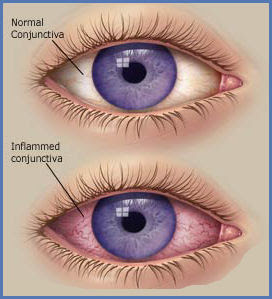 Conjunctivitis is a common eye disease that may be caused by excessive eye strain or infections due virus or bacteria. Conjunctivitis or pink eye is one of those conditions that effect children, adults and animals. It can be highly contagious and some people, particularly children, seem to suffer repeat bouts of it.
Conjunctivitis is a common eye disease that may be caused by excessive eye strain or infections due virus or bacteria. Conjunctivitis or pink eye is one of those conditions that effect children, adults and animals. It can be highly contagious and some people, particularly children, seem to suffer repeat bouts of it.Conjunctivitis is a highly contagious disease and it is treatable. The human body itself takes measures to cure the pink eyes. Since the soreness causes pain, many home treatments are suggested and they also found to be very effective.
Types of Conjunctivitis
Allergic conjunctivitis
Allergic conjunctivitis is often caused by dust mites, pollen and cosmetics and is common in people who have hay fever, asthma and eczema. It can cause mild to severe itching and often makes the eyes red and sore. If it's seasonal conjunctivitis it may just last a few weeks, however, allergic conjunctivitis may be consistent if you live around animals or are allergic to house dust. Speak to your doctor or pharmacist if you're worried about this condition and take antihistamines as prescribed.
Viral conjunctivitis
Viral conjunctivitis usually occurs after a cold or a sore throat and it is highly contagious.
It causes a watery discharge to leak from the eye and can spread easily from one eye to the other. It can turn the eye pink and might can also cause itching if it becomes particularly nasty. Viral conjunctivitis usually clears up by itself; however, ocular lubricants and painkillers can ease the symptoms. If you've got this disease it's essential that you always wash your hands thoroughly and to remove discharge using a clean cotton bud.
Bacterial conjunctivitis
Bacterial conjunctivitis is caused by bacteria such as staphylococci, streptococci or haemophilus and is a particularly nasty form of the condition. It causes the eyes to feel gritty, inflamed and sore and a yellow, sticky discharge may form sticking the eyes together overnight. Bacterial conjunctivitis usually lasts a week, but antibiotic drugs can help. Like viral conjunctivitis, it's highly contagious, so always maintain a high level of hygiene if you're infected and visit your optometrist if you have any concerns.
Symptoms of Conjunctivitis
The pink eye effect is one of the first signs of conjunctivitis. The sufferer may complain of dry or itchy eyes and, particularly children, will tend to rub them a lot. There can also be a discharge from the eye - this can range from a clear watery look to yellow or green. The color is often an indication of what type of conjunctivitis the person is suffering from. In severe cases, the eyes may be glued shut on waking. This is caused by the discharge weeping out from between the eyelids during sleep, then drying on the eyelashes, effectively gluing them together.
Nursing Diagnosis for Conjunctivitis
1. Acute Pain
related to inflammation of the conjunctiva
characterized by:
Clients say the discomfort (pain) is felt
The face looks the pain (pain expression).
2. Anxiety
related to lack of knowledge about the disease process
characterized by:
Clients say about anxiety.
Clients look anxious and nervous.
3. Self-concept disturbance
related to a change in the eyelid (swelling / edema).
4. Risk for injury
related to the limits of vision.